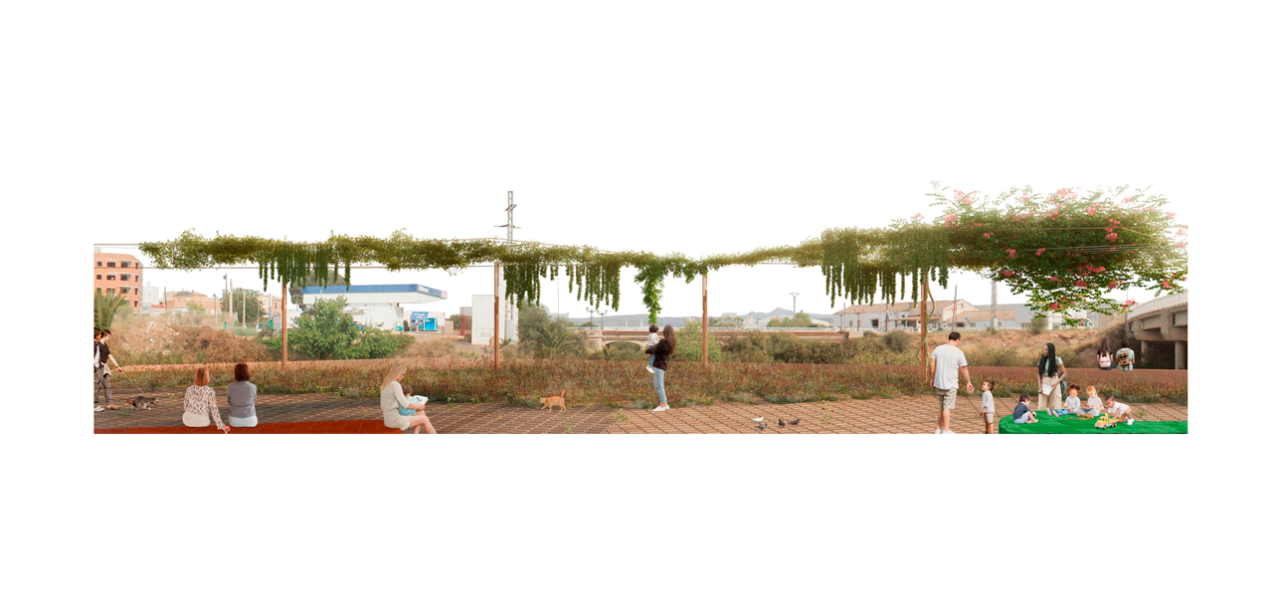

Les passeres del riu
Carpe Estudio
mha_arquitectura
Adrián Ripoll. Arquitecto
The proposal aims to enhance the positive aspects we noticed on our initial visit and minimize those that detract from the site’s inherent value. Our goal is to improve the experience of walking through and staying in the area. Imagine a path between the canal and the riverbed, over ceramic gravel and fallen leaves, featuring the existing buildings, colorful benches, and views framed by a new pergola.
Along the route, benches of various geometries made from glazed stoneware invite gathering and rest at key points. A new shaded area, provided by a pergola, offers privileged views. These interventions create an easily recognizable footprint. The material and color help identify it as an additional layer to the site, a new stratum among the existing ones.
From the southern entrance of the plot, a carpet of ceramic gravel welcomes us, covering a triangular area that will eventually be replaced by a planned new road. Since this is a temporary pavement, we used recycled and permeable materials that leave no lasting mark and avoid excessive economic expenditure in an area that will be reworked later. The canal is revealed at this point and covered with corrugated steel bars that allow passage and stoneware pieces on the sides of the canal from the Exagres Gresan Natural Series, smooth strip model with dimensions of 6 x 24.5 cm.
Moving north within the plot, we encounter the first colored ceramic element: a bicycle rack and fountain that welcome visitors to the site in a resting space, materialized in stoneware with a geometric design from the Exagres Gresan Natural Series.
Around the existing building, where no intervention is planned, the area is prepared as a welcoming space. Adhering to a key principle of the project, we only do what is necessary and avoid resource expenditure in an area that will be addressed later and is not part of the current proposal. From here, the path bifurcates:
To the right, new terraces gently descend to form two platforms intended as resting areas. Their height is managed with a step, repeating the strategy of the bicycle rack and welcoming fountain with glazed stoneware pieces.
To the left, a ramp bridges the slope to the large terrace facing the riverbed.
Under the shade of a very light new pergola, made with corrugated steel bars and cables awaiting vegetation, the corrugated profiles, kinder in their contact with people, pass through cylinders of stoneware from the Exagres Gresan Curtain Series.
The unique characteristics of the proposal’s setting lead us to consider concepts like safety and accessibility in the use of these spaces. The proposal aims to allow safe use of the area without excessive intervention that could diminish its virtues. Access is facilitated with pavements that enable a natural flow through the site; large ramps, benches, bicycle racks, a fountain, and shaded spaces reinforce the idea that this is a place for everyone.
Our proposal emphasizes the following points:
Lighting: Adequate lighting ensures the perception of safety and maximum visibility at all times.
Climate protection: Rest areas are located in both shaded and sunny spots to be usable year-round.
Rest areas: 300 m² of exterior space are designated for rest. Additionally, a bench is placed every 10 meters along main access routes to facilitate access for people with reduced mobility. This furniture is arranged to encourage interaction and dialogue among the different groups the centers will host.
Water fountain and spaces for eating and resting at different levels.
A fundamental aspect we believe the project must meet is to be respectful of the environment and aware of its location. The proximity to the river and the potential for flooding lead us to propose permeable pavements, where pieces are set on ceramic gravel. These will result from crushing ceramic remnants from nearby factories, which will be used to create a ceramic tapestry on which selected stoneware pieces will be placed.
The project execution involves using local, everyday materials, without the need for excessive resources or advanced technological knowledge, but rather careful craftsmanship that pays attention to detail. In this way, the work could be carried out by local workers, without needing to bring in large companies with greater technical resources.
As we will see later in the report, the chosen ceramic material is a product from the local company Exagres in Betxí. By selecting a local company, we reduce the need to transport materials over long distances, thereby decreasing the carbon footprint. Our goal has been to minimize environmental impact while achieving much with little.
The proposal stems from the impressions the site and its surroundings offered during our initial visit and a detailed study of the needs expressed in the technical report. This fits into an ambitious project to enhance the banks of the Riu Sec throughout the municipality, reclaiming and bringing it closer to its residents. The name “River Walkways” harkens back to the children’s games in the old stream bed and nods to our benches as transition markers between the terraces, which in the same way can be a playground for today’s and tomorrow’s children. We see our proposal as a path integrated into the network of rural routes connected to the river, providing a space for community interaction, dotted with resting spots to relax, observe the natural surroundings, and learn: geometric elements that rise from the ground like sculptures, offering places to recline, interact, and rest. Additionally, a pergola serves as a filter between the urban core and the riverbank, creating a new window that frames the landscape. The welcoming plaza at the southern edge, with a pergola, fountain, and bicycle rack, also aims to be the entrance to the future building that will be developed in the existing house. It is located at the junction of various rural paths connected to the rivers, and with the fence of the plot removed but the existing trees preserved, it becomes a more welcoming, open, and safe space.

